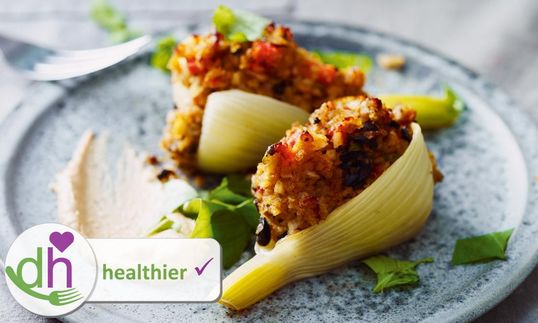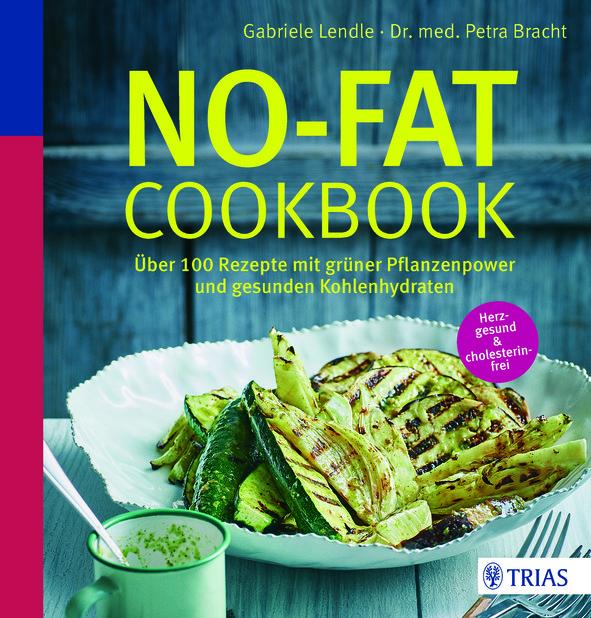Healthy, Mediterranean stuffed fennel with green spelt
vegan
Ingredients (for servings, )
Equipment
- blender or hand-held blender / immersion blender
- skillet (frying pan)
- stove
- coffee grinder, electric
- citrus juicer (lemon squeezer)
- saucepan
- skimmer
- oven
- casserole dish (baking dish)
- sieve
Type of preparation
- cook
- bake
- chop or grind
- blanch
- blend
- squeeze
- season to taste
- sauté
- remove the skin
- drain
- Quellen lassen (ausquellen)
Preparation
For the fennel
Boil ground grain (e.g. green spelt) with water and leave to swell covered for 15 minutes with the stove turned off.
In the meantime, proceed with the next steps.In addition to green spelt, spelt or emmer are also suitable as crushed grains.
Wash the fennel bulbs, cut off just enough of the stalk to allow you to strip off the outer layers of fennel, including the stem. Depending on the size of the fennel, you will need 6-8 pieces. Blanch them in boiling salted water for 5 minutes, remove with a slotted spoon and drain in a sieve.
Use the leftover fennel bulbs for another purpose.The author recommends using two large fennel bulbs.
Briefly place the tomatoes in boiling water so that they can be easily peeled. Then dice the tomatoes. Finely chop the olives. Peel the garlic and onion and chop finely. Wash the peppers and cut into thin rings.
Depending on how hot you want it to be, choose a hotter or less hot pepper. If it is still too hot for you, you can also remove the seeds.
Heat some water in a pan and fry the onion, garlic and peppers for 2 minutes. Add the grain meal and diced tomatoes and sauté for about 5 minutes until the grain meal is crumbly, turning it with a spatula.
Add olives and lemon juice and season with spices.
Spoon the filling into the fennel shells and place in a lightly greased baking dish. Bake in a preheated oven at 200 °C top/bottom heat for 15 minutes.
Meanwhile, wash the basil and roughly chop it with your fingers. Chop the walnuts.In the original recipe, the author uses 2 tablespoons of olive oil for greasing. We deliberately replaced olive oil with rapeseed oil and reduced the amount.
Motivation (apple symbol) and link to the original recipe can be found directly above the recipe picture.For the "cheese cream"
Grind fenugreek and savory or use the ground ones directly. Mix the macadamia nuts with the water in a high-performance blender to form a cream and stir in a bowl with the remaining ingredients for the "cheese cream".The original recipe uses 60 g cashew nuts (alternatively 2 tablespoons cashew butter) and 60-80 ml water for 2 portions.
Arranging and Serving
Sprinkle the baked fennel with basil and walnuts and serve with "cheese cream".The original recipe does not contain walnuts.
|
Nutritional Information per person
Convert per 100g
|
2000 kcal | |
|---|---|---|
| Energy | 563 kcal | 28.1% |
| Fat/Lipids | 32 g | 45.1% |
| Saturated Fats | 4.5 g | 22.6% |
| Carbohydrates (inc.dietary fiber) | 67 g | 24.7% |
| Sugars | 18 g | 19.6% |
| Fiber | 19 g | 75.4% |
| Protein/Albumin | 14 g | 28.3% |
| Cooking Salt (Na:334.8 mg) | 850 mg | 35.4% |
| Essential micronutrients with the highest proportions | per person | 2000 kcal | |
|---|---|---|---|
| Vit | Vitamin K | 214 µg | 285.0% |
| Min | Manganese, Mn | 3.2 mg | 162.0% |
| Vit | Vitamin B1 (Thiamine) | 1.1 mg | 97.0% |
| Elem | Potassium, K | 1'808 mg | 90.0% |
| Min | Copper, Cu | 0.75 mg | 75.0% |
| Vit | Vitamin B9, B11 (Folate, as the active form of folic acid) | 149 µg | 74.0% |
| Vit | Vitamin C (ascorbic acid) | 56 mg | 70.0% |
| Fat | Alpha-Linolenic acid; ALA; 18:3 omega-3 | 1.3 g | 63.0% |
| Elem | Phosphorus, P | 429 mg | 61.0% |
| Fat | Linoleic acid; LA; 18:2 omega-6 | 6.1 g | 61.0% |
Detailed Nutritional Information per Person for this Recipe
The majority of the nutritional information comes from the USDA (US Department of Agriculture). This means that the information for natural products is often incomplete or only given within broader categories, whereas in most cases products made from these have more complete information displayed.
If we take flaxseed, for example, the important essential amino acid ALA (omega-3) is only included in an overarching category whereas for flaxseed oil ALA is listed specifically. In time, we will be able to change this, but it will require a lot of work. An “i” appears behind ingredients that have been adjusted and an explanation appears when you hover over this symbol.
For Erb Muesli, the original calculations resulted in 48 % of the daily requirement of ALA — but with the correction, we see that the muesli actually covers >100 % of the necessary recommendation for the omega-3 fatty acid ALA. Our goal is to eventually be able to compare the nutritional value of our recipes with those that are used in conventional western lifestyles.
| Essential fatty acids | per person | 2000 kcal |
|---|---|---|
| Alpha-Linolenic acid; ALA; 18:3 omega-3 | 1.3 g | 63.0% |
| Linoleic acid; LA; 18:2 omega-6 | 6.1 g | 61.0% |
| Essential amino acids | per person | 2000 kcal |
|---|---|---|
| Tryptophan (Trp, W) | 0.10 g | 41.0% |
| Threonine (Thr, T, irreversibly transaminated) | 0.33 g | 35.0% |
| Phenylalanine (Phe, F) | 0.49 g | 31.0% |
| Isoleucine (Ile, I) | 0.36 g | 29.0% |
| Leucine (Leu, L) | 0.64 g | 26.0% |
| Valin (Val, V) | 0.43 g | 26.0% |
| Lysine (Lys, K, irreversibly transaminated) | 0.25 g | 13.0% |
| Methionine (Met, M) | 0.12 g | 13.0% |
| Vitamins | per person | 2000 kcal |
|---|---|---|
| Vitamin K | 214 µg | 285.0% |
| Vitamin B1 (Thiamine) | 1.1 mg | 97.0% |
| Vitamin B9, B11 (Folate, as the active form of folic acid) | 149 µg | 74.0% |
| Vitamin C (ascorbic acid) | 56 mg | 70.0% |
| Vitamin B6 (pyridoxine) | 0.57 mg | 41.0% |
| Vitamin B3 (Niacin) | 5.0 mg | 32.0% |
| Vitamin A, as RAE | 245 µg | 31.0% |
| Vitamin B5 (Pantothenic acid) | 1.6 mg | 27.0% |
| Vitamin E, as a-TEs | 3.0 mg | 25.0% |
| Vitamin B7 (Biotin, ex vitamin H) | 11 µg | 23.0% |
| Vitamin B2 (Riboflavin) | 0.30 mg | 22.0% |
| Essential macroelements (macronutrients) | per person | 2000 kcal |
|---|---|---|
| Potassium, K | 1'808 mg | 90.0% |
| Phosphorus, P | 429 mg | 61.0% |
| Magnesium, Mg | 170 mg | 45.0% |
| Sodium, Na | 335 mg | 42.0% |
| Calcium, Ca | 245 mg | 31.0% |
| Essential trace elements (micronutrients) | per person | 2000 kcal |
|---|---|---|
| Manganese, Mn | 3.2 mg | 162.0% |
| Copper, Cu | 0.75 mg | 75.0% |
| Iron, Fe | 6.8 mg | 48.0% |
| Zinc, Zn | 2.9 mg | 29.0% |
| Selenium, Se | 4.2 µg | 8.0% |
| Fluorine, F | 99 µg | 3.0% |
| Iod, I (Jod, J) | 3.1 µg | 2.0% |
TRIAS Verlag, Thieme Verlagsgruppe, Gabriele Lendle
Raw recipes 6, Cooked recipes 104 (4)
Additional photos (6)
The "No-Fat Cookbook - over 110 recipes with green plant power and healthy carbohydrates" contains information and everyday, oil-reduced recipes.
Since this book is written in German, a description is omitted here. If you are interested, please switch to German in the menu.
The healthy, Mediterranean stuffed fennel with crushed grain (green spelt, spelt or emmer) is served with a vegan "cheese cream".
New nutrient profile: According to GDA guidelines, one portion of this recipe covers almost three times the recommended daily requirement of vitamin K. It also covers the requirement for manganese and vitamin B1. Through our adjustments, we were able to change the ratio of omega-6 to omega-3 fatty acids to 5:1, which means that it no longer exceeds the recommended maximum ratio of 5:1.
You can find more information behind this motivation at the following link: Vegans often eat unhealthily. Avoidable nutritional errors.
Fennel: Fennel belongs to the Umbelliferae family. The white to light green bulb is layered, similar to an onion, and has an intense aroma, which it owes to its high content of essential oils. The essential oils are also responsible for the health properties. Fennel supports digestion and is also said to have anti-inflammatory properties.
Green spelt: Green spelt is spelt harvested 2 to 3 weeks before it is ripe. This tradition of harvesting green spelt comes from the need for nutrient-rich staple foods for field work in summer. However, green spelt cannot be stored and is kilned or dried. Green spelt meal is made from spelt intended for green spelt, which is then ground after kilning. Like wheat, spelt and green spelt contain gluten, which can cause health problems for people with celiac disease (gluten intolerance). In terms of the vitamin and mineral content, there are only minimal differences compared to wheat. However, the silica content of spelt is significantly higher than that of wheat.
Macadamia nuts: Due to their fine aroma, macadamia nuts are one of the tastiest nuts in the world. They contain many minerals and B vitamins. The ratio of omega-6 to omega-3 fatty acids is 6:1. The cashew nuts used in the original recipe, on the other hand, have a very poor ratio of omega-6 to omega-3 fatty acids at 48:1.
Walnuts: Of all known nuts, walnuts have the highest content of alpha-linolenic acid (ALA). They also have health benefits thanks to tocopherols (forms of vitamin E) and many macro and trace elements.
Fenugreek: Aroma and taste reminiscent of lovage and celery.
Schabzigerklee: The aroma of Schabzigerklee is more like green pepper or spinach.
Grain meal: Instead of green spelt, you can just as easily use spelt or emmer meal.
Making green spelt groats: You can easily make the green spelt groats used here yourself. This can be done relatively quickly, for example, with an (electric) coffee grinder, which can grind smaller portions well. Green spelt that you grind yourself is usually of a higher quality than ready-made products that are available for purchase, which are exposed to oxidation processes for a longer period of time due to the presence of oxygen. An alternative if you don't have a coffee grinder is to soak the grains, then boil them briefly and process them using a hand blender. With the latter method, however, you should keep an eye on the cooking time, as otherwise the processed green spelt will lose its firmness.




